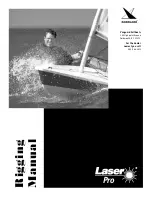
3-26
3
O
PERATION
CroSSinG WaKES anD SWELLS
You will not always have flat, smooth
water. There will be swells and wakes
from other boats, etc.
The best way to cross wakes and swells
is with the least jolt to you and the boat.
Small swells are not as difficult to cross
as larger swells or wakes. Crossing a
sharp wake gives more of a jolt than a
broad swell.
To cross a wake or swell, change your
speed and choose the angle at which
you cross the wake or swell. Usually,
a slower speed and “quartering” the
wake (crossing at an angle) will reduce
the jolt.
Two other things you may notice. The
first is that crossing a group of wakes
or swells is not as easy or smooth as
crossing just one wake. The second is
that when you quarter the wake or swell
the boat will try to steer away from the
wake or swell. When crossing at a 45°
angle, you may not notice this, but at a
smaller angle, say 10°, it can be very
strong. Be prepared to steer and bal-
ance as necessary.
WaKE
90°
45°
10°
Sharp WaKES
BroaD SWELL
Содержание 212SS
Страница 4: ......
Страница 6: ......
Страница 8: ......
Страница 30: ......
Страница 54: ......
Страница 56: ......
Страница 90: ......
Страница 112: ......
Страница 120: ......
Страница 135: ... 2008 Yamaha Motor Corporation U S A Printed in U S A LIT 18626 08 23 212SS 212X OWNER S OPERATOR S MANUAL ...
















































